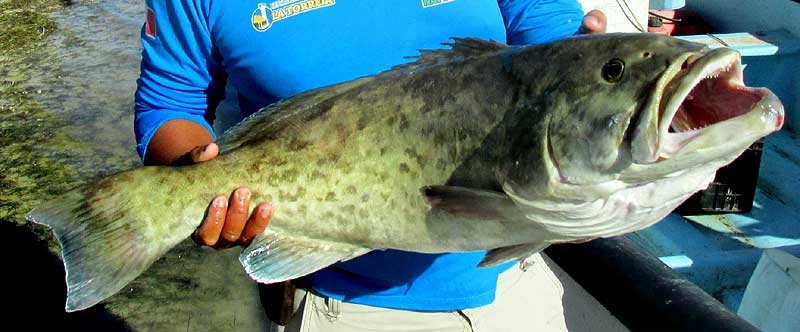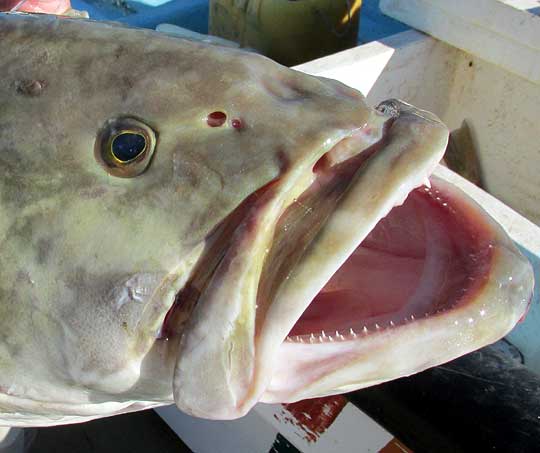Excerpts from Jim Conrad's
Naturalist Newsletter

from the March 22, 2015 Newsletter issued from Río Lagartos, on the Yucatan Peninsula's northern coast (~N21.60°, ~W88.16°), Yucatán state, MÉXICO
BLACK GROUPER
Rayo and I were returning by boat from a wander in mudflats left exposed at low tide when a friend of Rayo's turned up on the canal's banks cleaning fish next to his boat. All night he'd been fishing far offshore in the Gulf of Mexico. Now he was headed home, but needed to clean his catch before settling down. He didn't see any reason to mess up things at his house, so he was cleaning fish at the water's edge, tossing guts and such to dozens of gulls swarming around him. Rayo snooped in his friend's catch box, let out a whoop, and pulled out what's shown above.
A close-up of the head, showing short canine teeth for ripping into prey projecting downwards from the top mandible, and side-by-side rows of short, sharp teeth on the bottom, for holding prey, appears below:

I always feel bad seeing critters snatched from the wild ending up like this, but that's the way people here live, and this is when I get to see the fish. At least now I could admire the species' wonderful adaptations and the esthetic flourishes it was graced with.
Rayo said the fish was a grouper, and that was interesting because in this Newsletter we've already profiled two grouper species from the Gulf's waters here. You might enjoy comparing the present grouper with the others, one of which was the Calico Grouper shown at www.backyardnature.net/mexnat/grouper2.htm.
The other was the Red Grouper, shown at www.backyardnature.net/mexnat/grouper.htm.
This one's basic structure -- its generally chunky body, its big mouth with massive lower lip, the configuration of its fins and spines -- was similar to the other species, but its coloration and patterning definitely was different.
Groupers are important fish for commerce, so there's plenty of information about them. For example, there's the 1994 US-government NOAA publication by Mark Grace and others, entitled Pictorial Guide to the Groupers (Teleostei: Serranidae) of the Western North Atlantic, which treats about 25 grouper species.
Using that work and others, our big fish with its white-fringed fins and dark splotches on a pale background, and blackish smudge on the rear or caudal fin, turned out to be the Black Grouper, MYCTEROPERCA BONACI. Most Black Grouper photos show them with larger, darker splotches than ours. I think ours has faded a lot during its overnight stay a catch-box.
Black Groupers inhabit rocky zones and coral reefs of the Western Atlantic, from Bermuda and Massachusetts south through the Gulf of Mexico and Caribbean to southern Brazil. Commonly Black Groupers reach about 2.3 feet long (70cm), though they can grow to 5 feet (1.5m), so ours is a fair-sized one, but not close to as big as they can get. Black Groupers are thought of as providing excellent eating, so there's a market for them, largely explaining why the species now is listed on the IUCN Red List as Near Threatened. One feature working against the Black Grouper is that it reproduces relatively slowly.
Black Groupers are "protogynous hermaphrodites," which means that the young are predominantly female, but transform into males as they grow larger.
Adults feed mainly on other fish and squid, though younger fish feed on crustaceans, especially shrimp.